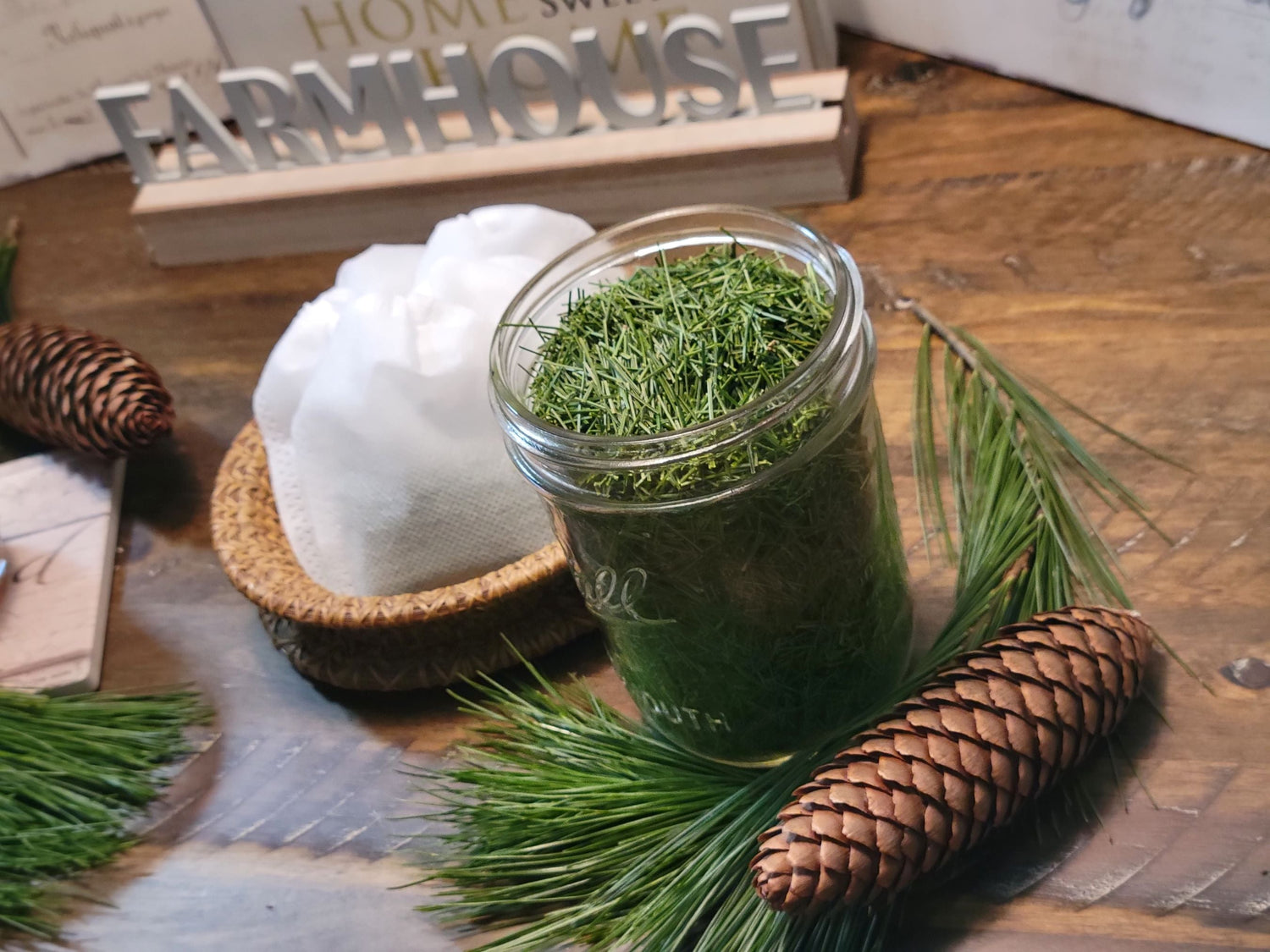
Pine Needle Tea: A Natural Antidote to Spike Protein Contagion
Eastern White Pine Tree
Several compounds found in pine needles have been identified as a potential antidote to the current spike protein contagion resulting from the chimeric SARS-CoV-2 coronavirus, and the potential pathogenic transmission of the spike protein from the experimental mRNA vaccines.
Eastern white pine tree needles (Pinus Strobus) contain many beneficial constituents useful for the prevention of colds and flu such as Alpha-Pinene, Beta-Pinene, Beta-Phellandrene, D-Limonene, Germacrene D, 3-Carene, Caryophyllene, vitamin A, and vitamin C. Eastern white pine needles also contain shikimic acid, the same molecule found in star anise herb used historically in Traditional Chinese Medicine to treat plagues and respiratory illness.
Pine needles have been used to make Pine Needle Tea by indigenous populations around the world as both food and medicine for thousands of years. Fresh pine needles from Eastern White Pine trees and other appropriate trees have been used for centuries as sources of vitamin C and other phytochemicals that Native Americans used to treat respiratory infections and other ailments. Vitamin C is a known cure for scurvy, as scurvy is a disease of vitamin C deficiency. Pine needles contain many other substances that appear to reduce platelet aggregation in the blood, potentially preventing blood clots that lead to strokes, heart attacks, and pulmonary embolism diagnoses.
The Compound Suramin
Suramin is strongly inhibitory to the replication of the coronavirus spike protein. It also has an inhibitory effect against components of the coagulation cascade and the inappropriate replication and modification of RNA and DNA. Excessive coagulation causes blood clots, mini-clots, strokes, and unusually heavy menstrual cycles, which are now being daily reported to VAERS post-vaccination. Recent research has shown it to be an in vitro inhibitor of SARS-CoV-2 infection in cell culture by preventing viral entry. Research shows this to be due to its potent inhibition of SARS-CoV-2 RNA-dependent RNA polymerase (RdRp), an essential viral lifecycle enzyme. It is proposed that suramin is 20 or more times as powerful as remdesivir, currently used as an anti-COVID-19 drug.1, 2, 3
Suramin originally is derived from trypan blue derived from toluene a derivative of pine oil.
When suramin was introduced for the treatment of African sleeping sickness in 1922, it was one of the first anti-infective agents that had been developed in a medicinal chemistry program. Starting from the antitrypanosomal activity of the dye trypan blue, synthesized in 1904 by Paul Ehrlich, Bayer made a series of colorless and more potent derivatives. Molecule 205 was suramin, synthesized by Oskar Dressel, Richard Kothe, and Bernhard Heymann in 1916. Pine needle oil was used as a botanical source for trypan blue. Sleeping sickness (also known as human African trypanosomiasis was at the forefront of research at that time, not a neglected disease as it is today, and the development of suramin was a breakthrough for the emerging field of chemotherapy.
Trypan blue is so-called because it can kill trypanosomes, the parasites that cause sleeping sickness. Trypan blue is derived from toluidine, that is, any of several isomeric bases, C14H16N2, derived from toluene. Trypan blue is also known as diamine blue and Niagara blue. Toluene is also a derivative of pine oil. The compound was first isolated in 1837 through a distillation of pine oil by the Polish chemist Filip Walter, who named it rétinnaphte.
Pine-Sol was based on pine oil when it was created in 1929 and during its rise to national popularity in the 1950s. However, as of 2016, Pine-Sol products sold in stores no longer contain pine oil to reduce costs.
Yet Pine Needle Tea provides a similar, if not superior, benefit, due in part to the fact that it is a direct mild extract of the whole herb leaving many of its properties still intact that might be destroyed by excessive heat during distillation and further dissection of its many nutrient components.

More on Suramin
Suramin is a polysulphonated naphthylurea with a potential antiviral, antiparasitic and antineoplastic activity that has been widely used in the clinical treatment of parasites and viral infections. It has also been used in the treatment of trypanosomiasis (sleeping sickness) and onchocerciasis since the early 1920s. Particularly, it is effective to treat African sleeping sickness caused by Trypanosoma brucei rhodesiense and Trypanosoma brucei gambiense without affecting the central nervous system. It is usually administered by intravenous injection. The mechanism of action of suramin is unclear, but parasites are thought to be able to selectively take suramin through receptor-mediated endocytosis of a drug that is bound to low-density lipoproteins and, to a lesser extent, other serum proteins. Once found inside parasites, suramin combines with proteins, especially trypanosomal glycolytic enzymes, to inhibit energy metabolism. It is also used in the treatment of river blindness or Onchocerciasis, a disease caused by infection with the parasitic worm Onchocerca volvulus. Symptoms include severe itching, bumps under the skin, and blindness. It is the second-most common cause of blindness due to infection, after trachoma.
Suramin has also been shown to be an inhibitor against a wide variety of other viruses, including Zika and Chikungunya viruses, indicating its diverse mechanisms of action against multiple viruses.4, 5, 6, 7, 8, 9, 10 Zika virus is a mosquito-borne flavivirus that mostly causes asymptomatic infections or mild disease characterized by low-grade fever, rash, conjunctivitis, and malaise. Chikungunya virus is a mosquito-transmitted alphavirus that can cause a debilitating disease that is primarily characterized by persistent joint pain.
Suramin History
Suramin was first produced by chemists Oskar Dressel, Richard Kothe, and Bernhard Heymann in the laboratories of Bayer AG in Elberfeld after research into several urea-like compounds. Bayer still sells the drug under the Germanin brand. The chemical structure of suramin was kept secret by Bayer for commercial and strategic reasons but was clarified and published in 1924 by Ernest Fourneau and his team at the Pasteur Institute.
Mechanism Identified Whereby Suramin Inhibits SARS-CoV-2 RdRp
Thus, research shows that suramin is a direct and potent viral RdRp inhibitor by direct inhibition, with structural analysis showing the mechanism of binding and inhibition. This is the first non-nucleotide inhibitor of the SARS-CoV-2 RdRp, and this indicates the potential to develop suramin analogs and drug formulations as potent and effective inhibitors of viral replication.
Comparing the RdRp-suramin complex to the remdesivir-bound RdRp complex shows that the two suramin molecules occupy specific positions on the RNA strand and the primer strand, blocking the binding of the duplex RNA template-primer strand to the active site of the enzyme. Simultaneously it prevented the entry of nucleotide triphosphate into the catalytic site. This directly blocked RdRp catalytic activity.11

Suramin and Cancer Therapy
Not only has suramin from pine needles been used traditionally for viruses and parasites, but suramin-based drugs have been extensively tested as a treatment for several types of cancers..12, 13, 14, 15, 16, 17 Technically, as an anti-cancerous compound suramin blocks the binding of various growth factors, including insulin-like growth factor I (IGF-I), epidermal growth factor (EGF), platelet-derived growth factor (PDGF), and tumor growth factor-beta (TGF-beta), to their receptors, thereby inhibiting endothelial cell proliferation and migration. This agent also inhibits vascular endothelial growth factor (VEGF)- and basic fibroblast growth factor (bFGF)-induced angiogenesis; retroviral reverse transcriptase; uncoupling of G-proteins from receptors; topoisomerases; cellular folate transport; and steroidogenesis.18, 19, 20, 21, 22
The inhibitory effect of suramin from pine needles on the coronavirus spike protein, Zika and Chikungunya viruses, and certain parasites warrant further evaluation of this naturally occurring compound as a potential broad-spectrum therapeutic.
So you can see that drinking Pine Needle Tea has many amazing health benefits - many of which we already understand and many are still being studied. Purchase our fresh, wild and organic Pine Needle Tea in bagged form or in loose needles by clicking on the "Shop" button at the top of the page.
Disclaimer: The information provided on this site is for educational purposes only and does not substitute for professional medical advice. Please consult your physician prior to consuming any of our Pine Needle Tea products. Pregnant or nursing women should not consume Pine Needle Tea.


